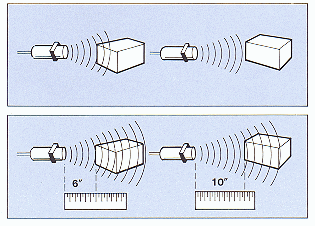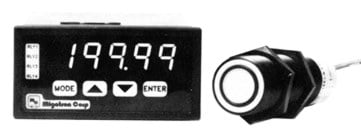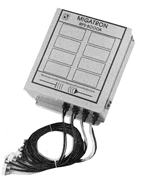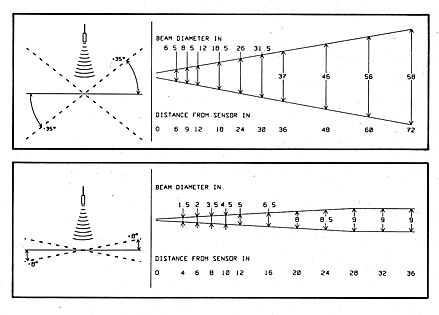FAQs
Home » FAQS
General
An ultrasonic sensor is a device that uses ultrasonic waves to measure distance, detect objects, or gauge fluid levels by emitting high-frequency sound waves and analyzing their reflections.
Ultrasonic sensors service the market by providing a cost effective sensing method with unique properties not possessed by other sensing technologies. By using a wide variety of ultrasonic transducers and several different frequency ranges, an ultrasonic sensor can be designed to solve many application problems that are cost prohibitive or simply cannot be solved by other sensors.
- Long range detection: In industrial sensing, more and more applications require detection over distance. Ultrasonic sensors detect over long ranges up to forty feet, while limit switches and inductive sensors do not.
- Broad area detection: While some photo electric sensors can detect over long distances they lack the ability to detect over a wide area without using a large number of sensors. The advantage of Migatron’s ultrasonic sensors is that both wide and narrow areas can be covered. All it takes is the proper ultrasonic transducer selection.
- Widest range of target materials: Only ultrasonic sensors are impervious to target material composition. The target material can be clear, solid, liquid, porous, soft, wood and any color because all can be detected.
- Non contact distance measuring: Because sound can be timed from when it leaves the transducer to when it returns, distance measuring is easy and accurate to .05% of range which equates to +or- .002 of an inch at a distance of 4 inches
It is Migatron’s continuing goal to provide ultrasonic sensors in industrially hardened packages that are electrically and electronically compatible with standard controls used in today’s industrial marketplace.
When used for sensing functions, the ultrasonic method has unique advantages over conventional sensors… Measures and detects distances to moving objects. Impervious to target materials, surface and color. Solid-state units have virtually unlimited, maintenance-free lifespan. Detects small objects over long operating distances. Resistant to external disturbances such as vibration, infrared radiation, ambient noise and EMI radiation. Ultrasonic sensors are not affected by dust, dirt or high-moisture environments. Ask your representative about Migatron’s full line of over 150 ultrasonic sensing devices: loop controls, robotic sensing, sensors to sort and transfer product by height, to count and measure, level detection of liquids and solids, distance measuring, part distinction, reflective counting, web brake detection, roll diameter, tension control and winding/unwinding regulation, slacking height control, proximity and ranging detection for AGV’s, people detection for counting or security, thickness measuring and much more including custom sensor manufacturing for OEM applications. Migatron’s experience with so many successful applications has enabled standardization and a reduction of sensor costs! Plus, sensors are available with options to accommodate specific applications for stringent operating requirements. Options include: sealed transducers, high gain, hysteresis control, separate transducers for thru beam detection, analog outputs and multi-channel systems.
At Migatron, we’re asked everyday to solve specific application problems with unique design parameters. As a result, we offer over one hundred and fifty different types of sensors and countless application solutions. For example, one Migatron customer needed to monitor the liquid level of a warm acid bath and provide a continual status report to a process control. The bath tank was five feet deep. Migatron considered the problem and recommended an ultrasonic sensor with the following: A stainless steel transducer and housing to withstand the acid fumes. A threaded sensor for easy mounting. An operating frequency that eliminates ambient and background noise, yet offers a consistent range of at least 80″. An analog signal output compatible with the controllers. Use of available on-site voltage to drive the sensor. The recommended sensor was the RPS-426A-80 which features a stainless steel threaded barrel unit with a 80″ range and analog output. It proved to be the perfect solution.

Two Ultrasonic Sensor Types
Proximity detection: An object passing anywhere within the preset range will be detected and generate and output signal. The detect point is independent of target size, material or degree of reflectivity. Ranging Measurement: Precise distance(s) of an object moving to and from the sensor are measured via time intervals between transmitted and reflected bursts of ultrasonic sound. The example shows a target detected at six inches from the sensor and moving to ten inches. The distance of change is continuously calculated and outputted.
Since 1979, Migatron has led the industry in the design and manufacture of industrially hardened sonic sensors and advanced solution-based technology for difficult sensing/control applications. Migatron offers:
- Wide and narrow beam units with digital or analog outputs.
- Units that operate over a variety of voltage ranges.
- Self-contained units with a wide variety of housings such as plastic, metal and stainless steel.
- Multi-transducer units that include temperature control compensation.
- Heated units for outdoor use.
Migatron’s transducers can be provided with:
- Time delays and/or span adjustments;
- Sensing ranges from 2 inches to 40 feet
- Multiplex controls to prevent cross talk between transducers
Migatron also offers custom manufacturing systems.
Migatron provides a control for those that have experienced the difficulty in applying analog devices. In the past, our customers used various control methods to convert the signal to usable engineering units as well as implementing various controls to monitor the signal. To simplify this process, Migatron has designed a stand alone control system that sets up easily. The control has both voltage and current inputs. Scaling allows real engineering units to be displayed while four programmable relay outputs give event and real-time control. The control has optional temperature compensation, two sensor input and/or a RS485 communications port. By electing the proper sensor, the meter offers a further dimension of control.

There are many cases where multiple transducers are required to provide systems information. Examples are contouring, sizing, measuring, quality control, sort and multiple part-selection. Migatron provides two-to-eight transducer systems with both analog and digital outputs. These systems come in a robust enclosure and can measure to .05% of range which equates to +/-.002 of an inch at 4 inches. Migatron serves a diverse customer base. Our experience with some of the nations leading companies is your assurance of quality, excellent service and reliability. Industries using Migatron’s ultrasonic sensors include automotive, petrochemical, machine-tool, pharmaceutical, printing, baking, food processing, glass, film and steel to name a few.

Target angle: This term refers to the “tilt response” limitations of a given sensor. Since ultrasonic sound waves reflect off the target object, target angles indicate acceptable amounts of tilt for a given sensor. If an application requires a target angle beyond the capabilities of a single sensor, two sensors can be teamed up to provide even a broader angle of tilt. Beam Spread: This term is defined as the area in which a round wand will be sensed if passed through the target area. This is the maximum spreading of ultrasonic sound as it leaves the transducer.

Ultrasonic sensors emit short bursts of ultrasonic waves and measure the time it takes for the waves to bounce back after hitting an object. By calculating the time difference, the sensor determines the distance to the object.
Ultrasonic sensors find applications in various fields including robotics, automotive parking assistance, industrial automation, liquid level measurement, and object detection in home security systems.
The range of ultrasonic sensors can vary depending on the model and design. Typically, ultrasonic sensors can detect objects from a few centimeters up to several meters away.
Yes, ultrasonic sensors can be affected by factors like temperature, humidity, and air density, which can influence the speed and propagation of sound waves.
Ultrasonic sensors may struggle to detect transparent objects since these materials may not reflect sound waves effectively.
Yes, many ultrasonic sensors are designed for outdoor use, but their performance may be influenced by factors like wind, rain, and temperature variations.
The accuracy of ultrasonic sensors can vary depending on factors such as the sensor’s design, the distance to the object, and environmental conditions. Generally, they provide reasonably accurate distance measurements.
Yes, some ultrasonic sensors can detect multiple objects within their detection range, although the accuracy of detection may vary.
Yes, like many sensors, ultrasonic sensors may require calibration to maintain accuracy over time. Calibration ensures that the sensor’s readings align with the actual distances or conditions it is measuring.
Ultrasonic sensors figure out how far things are by sending out sound waves and listening for them to bounce back. They shoot out these waves, wait for them to hit something, and then count how long it takes for them to come back. Using the time it takes and how fast sound travels, they can tell how far away an object is. This helps them measure distances without touching anything, which is really useful for lots of different jobs.
To test an ultrasonic sensor, you can set up an experiment where you place objects at different distances from the sensor. Then, you can observe if the sensor accurately detects the objects and measures the distances correctly. Finally, check if the sensor gives consistent readings each time you run the test.
Ultrasonic sensors determine the distance of objects by sending out sound waves that bounce off the object and return to the sensor. However, if there is a solid barrier between the sensor and the object, the barrier will block the sound waves from reaching the sensor, resulting in inaccurate measurements. Therefore, it’s important to ensure that there are no obstacles obstructing the path between the sensor and the object being measured for the sensor to work properly.
Yes, ultrasonic sensors can detect water. They work by sending out sound waves, which bounce off objects and return to the sensor. When these sound waves encounter water, they reflect back to the sensor, allowing it to detect the presence of water.
Ultrasonic sensors are commonly used in industries like wastewater treatment and agriculture to measure water levels in tanks and reservoirs.
Shipping & Purchasing
Some of our products can be added to the cart and purchased via our e-commerce website.
For all other products please submit your information on the Get A Quote tab under the Products or Shop pages. Migatron will then contact you to assist and place the order. You can also call 815-338-5800 or 1-888-MIGATRON (1-888-644-2876).
Migatron accepts approved company purchase orders, American Express, Visa, and MasterCard.
Yes. Please feel free to call or send an email. Migatron is known for its personalized service and we look forward to hearing from you.
Yes, standard orders can be canceled before they are shipped. Custom orders may accrue a fee for cancellation.
Please view our terms of service for specifics on our return policy.
Migatron ships in-stock products within 24 hours of the order being placed. Custom orders are on a per-case basis and will be discussed with the customer.
